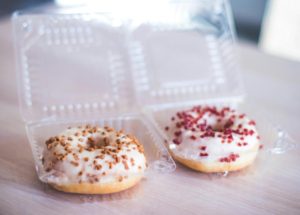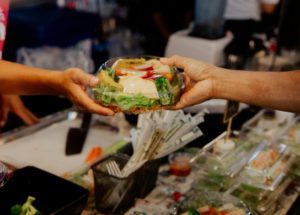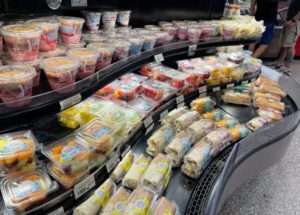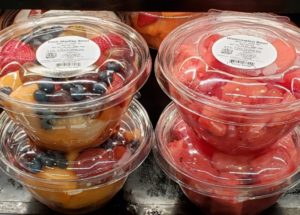Feb 27, 2025
What To Expect After Ordering Plastic Food Packaging
A food packaging order timeline typically includes tooling/setup, sample approval, production run, and delivery scheduling. Tooling and mold setup take weeks, especially for custom designs — plan ahead to meet launch dates. Sample review and approval are key checkpoints, ensuring fit, aesthetics, and seal performance before full production. Production lead times vary with volume and […]
Read More +
Feb 24, 2025
The Secret Ingredients in Food Packaging: Why You Need to Know How PET is Made
Plastic sheet production begins with melting and extruding PET resin into uniform sheets, often followed by stretching to boost strength. Sheet thickness controls performance, with heavier gauges offering better rigidity and barrier properties. Cooling and trimming steps ensure flatness and clean edges, critical for consistent downstream processing. Quality checks — like gauge measurement and visual […]
Read More +
Feb 20, 2025
Is Plastic Food Packaging Actually Safe to Hold Food?
Plastic food packaging safety relies on certified materials and migration testing to ensure food-contact compliance. Standard polymers like PET, HDPE, and PP are FDA-approved and widely used with decades of safe application. Additives are regulated and monitored, with most concerning compounds either banned or carefully controlled. Ongoing testing and transparent supplier documentation help maintain trust […]
Read More +
Feb 18, 2025
Is Custom Food Packaging a Smart Investment?
Custom food packaging enhances brand visibility and differentiation, helping products stand out on crowded shelves. Tailored designs improve functionality, matching your product’s size, shape, and shelf-life needs. Upfront costs are higher, but optimized packaging can reduce waste and increase perceived value. Scalable solutions and flexible runs allow testing and iteration without massive capital investment. Let’s […]
Read More +
Feb 13, 2025
Plastic Food Packaging Forecast Guide: Planning for Profit
Your plastic food packaging forecast highlights trends in sustainability, automation, and material innovation, guiding future strategies. Demand is shifting toward PCR content and lightweight, functional designs that balance performance and eco-impact. Automation and digital printing are growing, enabling faster line changeovers and more flexible branding. Brands that anticipate regulatory shifts and invest in recyclable systems […]
Read More +
Feb 11, 2025
Why Can’t I Buy Plastic Food Packaging Direct?
Buying food packaging directly cuts out middlemen, often reducing costs and improving customization control. You’ll need to vet suppliers thoroughly, checking certifications, quality control, and capacity. Bulk orders and forecasts allow better pricing, but require solid demand planning. Strong partnerships ensure smooth production, with clear communication, lead-time alignment, and contingency planning. “If I’m buying your […]
Read More +
Feb 04, 2025
Plastic Resin Price Drivers: From Raw Materials to Market Demand
Plastic resin price depends on feedstock costs, supply/demand, and global market dynamics, making pricing volatile and tied to oil and gas swings. Raw material ups and downs (like ethylene and propylene) ripple through resin costs to impact packaging budgets. Demand shifts from automotive, construction, and food sectors can tighten or ease resin supply. Regulatory changes, […]
Read More +
Jan 28, 2025
5 Problems with Plastic Fresh Food Packaging – And Tips to Overcome Them
Food packaging problems include seal failure and leakage, which can damage product quality and shelf life. Weak barrier performance leads to moisture loss or gas exchange, so choose polymers and structures tailored to each product. Container deformation during transit can be solved with optimized film thickness and improved handling protocols. Label durability and adhesion issues can […]
Read More +
Jan 22, 2025
Is American Plastic Food Packaging Actually More Expensive?
The cost of plastic food packaging in America is competitive with imports, as domestic production reduces freight, duties, and currency risk. Local sourcing speeds lead times and reduces inventory pressures, improving supply chain resilience. Quality control and freight savings often offset slightly higher domestic resin costs. Strategic partnerships and volume forecasting help secure better pricing […]
Read More +
Jan 15, 2025
7 Insider Tips to Get The Food Packaging You Need
Plastic food packaging manufacturer collaboration works best when you’re clear on specs, volume, and deadlines upfront. Request samples and run trials to validate fit, seal, and performance before full production. Negotiate pricing tiers and volume incentives to optimize cost as demand ramps. Maintain open communication — stay aligned on lead times, quality checks, and forecasting […]
Read More +











